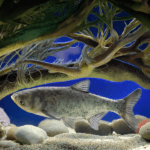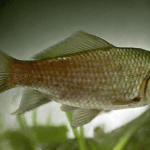Cyprinus carpio L. (1758) – Karp
Gatunek: Karp (ang. Common Carp).
Rodzina: Cyprinidae (karpiowate).
Rząd: Cypriniformes (karpiokształtne).
Królestwo: Animalia (zwierzęta).
Karp to ryba z rodziny karpiowatych, odgrywająca kluczową rolę w hodowli. W Polsce stanowi połowę odławianych ryb słodkowodnych. Globalnie rocznie odławia się około 200 tys. ton karpia. Wędkarze cenią go za waleczność i przebiegłość.
🔍 Występowanie
Dzika forma karpia pierwotnie występowała w południowo-wschodniej Europie i zachodniej Azji, w zlewiskach mórz Egejskiego, Czarnego, Kaspijskiego i Aralskiego. W wyniku hodowli, rozpoczętej w Europie Wschodniej około XII-XIII wieku, oraz licznych introdukcji, karp rozprzestrzenił się na niemal cały świat. W naturalnych warunkach przebywa w wodach stojących lub wolno płynących, występuje niemal we wszystkich strefach klimatycznych. Preferuje stawy, jeziora nizinne oraz płytkie przybrzeżne wody w cieplejszych okresach, natomiast w chłodniejszych przebywa przy dnie.
🔍 Osiągnięcia i Limity
Rekord Polski: 28,50 kg (nie dotyczy Jarosławek)
Złoty medal: 15,00 kg
Srebrny medal: 12,00 kg
Brązowy medal: 8,00 kg
- Największy jak do tej pory został złowiony na Węgrzech dokładnie 23 listopada 2018 roku przez Michela Schoenmakers na łowisku Euro-Aqua – 51,20 kg – 112,64 cm.
🔍 Zasady połowu
Okres ochronny: brak
Wymiar ochronny: 30 cm (nie dotyczy rzek)
Limit dziennego połowu: 3 sztuki (łącznie z amurem białym, boleniem, brzaną, lipieniem, pstrągiem potokowym, szczupakiem i sandaczem).
(Dla osób bardziej wnikliwych, które zauważyły kuriozum w limicie dziennym karpia, pragniemy wyjaśnić, że tego typu regulacje mogą być wprowadzone w celu uproszczenia przepisów i łatwiejszej ich egzekucji w stosunku do wędkarzy przez Straż Rybacką (SR) lub Społeczną Straż Rybacką (SSR), mimo że w praktyce takie połączenie limitu może być mało realne. Rzeczywiście jedynym miejscem, gdzie mogłyby być limitowane wspólnie ryby strefy górskiej i te żerujące w szybkim nurcie z opisywanym przez nas karpiem, jest talerz obiadowy, a raczej jego pojemność, ponieważ w polskich rzekach karp jest uważany za gatunek inwazyjny!)
🔍 Odmiany
Formy dzikie karpia (sazan) charakteryzują się wydłużonym, słabo ścieśnionym bocznie ciałem pokrytym dużymi, dachówkowato ułożonymi, łuskami cykloidalnymi. Rasy karpi hodowlanych, uzyskanych drogą selekcji, są mocno wygrzbiecone i mają relatywnie małą głowę. Niektóre odmiany hodowlane są całkowicie bezłuskie (goły, bezłuski) lub mają znacznie zredukowaną pokrywę łuskową (lampasowy, liniowy).
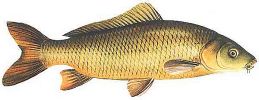
Sazan: ciało pokryte grubą, dobrze osadzoną łuską, tworzącą jednolitą pokrywę; bywa mylony z amurem.
Europa, prawdopodobnie zlewnia Dunaju: To jest prawdopodobne miejsce pochodzenia karpia dzikiego (Cyprinus carpio carpio) (sazan), który dał początek hodowlanym odmianom. Jednak dokładne określenie locus typicus jest trudne ze względu na długą historię hodowli i introdukcji karpia na całym świecie.
Podgatunki karpia:
Cyprinus carpio carpio
Status: Nominatywny podgatunek, czyli podgatunek typowy.
Zasięg: Europa, prawdopodobnie pochodzi z zlewni Dunaju (locus typicus).
Charakterystyka: Obejmuje większość hodowlanych odmian karpia, takich jak karp lustrzeń, pełnołuski, bezłuski (golec) czy karp zatorski.
Uwaga: Współcześnie wiele hodowlanych odmian karpia jest wynikiem selekcji i krzyżowania, dlatego ich klasyfikacja jako podgatunków jest dyskusyjna.
Cyprinus carpio haematopterus
Status: Karp dalekowschodni, często traktowany jako odrębny podgatunek.
Zasięg: Występuje w Azji Wschodniej, w tym w Chinach, Japonii i Korei.
Charakterystyka: Odmiany ozdobne, takie jak karp koi, należą do tej grupy.
Uwaga: W niektórych źródłach nazwa haematopterus jest używana jako synonim dla odmian azjatyckich, ale nie zawsze jest to jednoznaczne.
Cyprinus carpio viridiviolaceus
Status: Karp północnowietnamski.
Zasięg: Północny Wietnam.
Charakterystyka: Mniej znany podgatunek, występujący w naturalnych zbiornikach wodnych tego regionu.
Uwaga: Jego status systematyczny jest niepewny i wymaga dalszych badań.
Cyprinus carpio aralensis
Status: Karp z basenu Morza Aralskiego.
Zasięg: Historycznie występował w regionie Morza Aralskiego i jego dopływów.
Charakterystyka: Jego pozycja systematyczna jest niejednoznaczna, a obecnie jest rzadki ze względu na degradację środowiska w regionie Aralu.
Uwaga: Niektóre źródła traktują go jako populację Cyprinus carpio carpio, a nie odrębny podgatunek.
🔍Hodowlane Odmiany Karpi
Karp lustrzeń wyhodowany w Polsce, charakteryzuje się silnie wygrzbieconym ciałem i dużymi łuskami wzdłuż linii bocznej oraz w okolicach głowy. Ceniony za walory smakowe. Charakteryzuje się nieregularnym rozmieszczeniem dużych łusek na ciele.
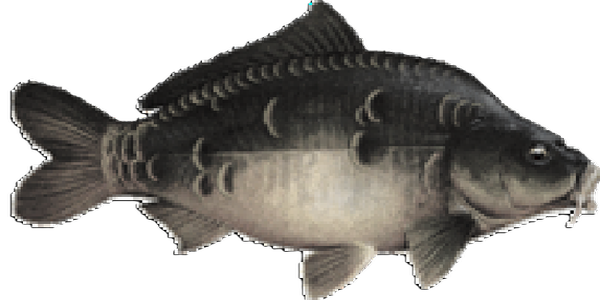
Karp lustrzeń Karp królewski: Ma łuski rozmieszczone wzdłuż linii bocznej i grzbietu, co odróżnia go od lustrzenia.
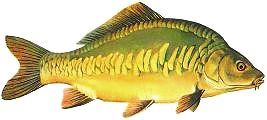
Karp królewski Karp pełnołuski: ciało w pełni pokryte łuskami, wytrzymały na zmiany środowiskowe; jedna z najstarszych i najczęściej hodowanych odmian.
Karp drobnołuski: mniejsze, delikatne łuski równomiernie rozmieszczone na ciele, nadają mu subtelniejszy wygląd.
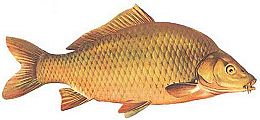
Karp bezłuski (golec): brak łusek na ciele, gładka i śliska powierzchnia, ceniony za smak i mięso bez twardych łusek.
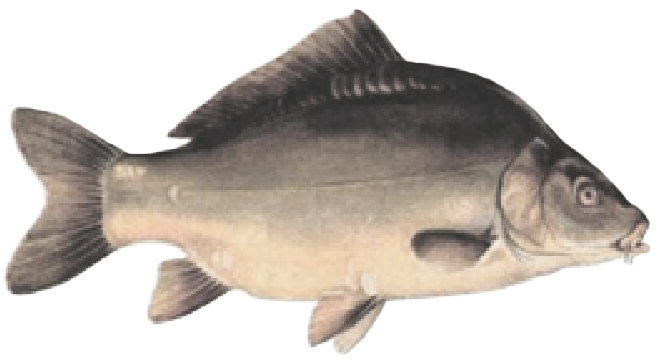
Karp bezłuski Karp koi: Cyprinus carpio haematopterus ozdobna odmiana z efektownym ubarwieniem (białe z pomarańczowymi, czerwonymi lub czarnymi plamami), hodowany w przydomowych stawach i sadzawkach.
Karp zatorski: charakteryzuje się lustrzanym ułuszczeniem (wieńcowe, strzałkowe lub siodełkowe), oliwkowo-niebieskie ubarwienie.
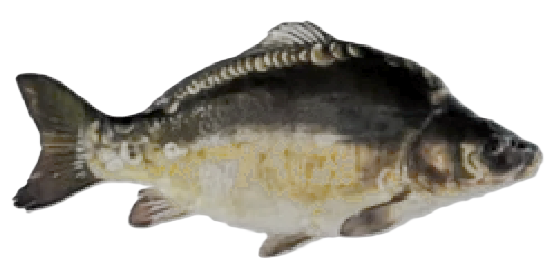
Karp zatorski
🔍 Międzynarodowe aspekty karpia
Karpiowate to popularna nazwa różnych ryb słodkowodnych z rodziny Cyprinidae, której przedstawiciele dominują w faunie rybnej Eurazji i Ameryki Północnej. Karpiowate odnosi się zwykle do większych gatunków cyprinidów, takich jak Cyprinus carpio (karp), Carassius carassius (karasie), Ctenopharyngodon idella (amur biały), Hypophthalmichthys molitrix (tołpyga biała) i Hypophthalmichthys nobilis (tołpyga pstra). Karpie od dawna są ważnymi rybami konsumpcyjnymi oraz ozdobnymi (JAK: koi CZY złota rybka-(karaś ozdobny)).

🔍 Karp w USA i Europie
Podczas gdy w Stanach Zjednoczonych karp nie zyskał statusu ryby sportowej i jest uważany za mało wartościowy przez wędkarzy łowiących bassy, w Europie jest cenionym trofeum. Właściciele jezior są gotowi zapłacić nawet 4000 funtów lub 7500 dolarów za karpia o wadze 40 funtów (ok 20 kg.), jeśli wędkarze łowią je na zasadzie złów i wypuść.
🔍 Sport karpiowy
W Wielkiej Brytanii najwcześniej w Europie, karp stał się jedną z najbardziej uwielbianych ryb sportowych. W późniejszym czasie sportowym łowieniem karpia zaraziła się praktycznie cała Europa. Obecnie w wielu krajach organizowane są specjalne łowiska typowo karpiowe, takie jak Euro Aqua na Węgrzech, znane z rekordowych karpi, oraz Balaton, największe jezioro w Europie Środkowej, popularne miejsce wędkarskie. Łowienie karpi stało się popularnym hobby. Istnieje wiele firm oferujących zanęty, przynęty, atraktory, dodatki, sprzęt specjalistyczny oraz akcesoria do wędkarstwa karpiowego, co świadczy o dużej popularności tej dziedziny wędkarstwa.
🔍 Historia hodowli karpia
Hodowla karpia ma długą historię, sięgającą VII wieku n.e. w Chinach, gdzie hodowano różne gatunki karpia ze względu na ich różne nawyki żywieniowe. Systemy wielokrotnego chowu obejmowały między innymi połączenie hodowli ryżu i ryb, gdzie ryby dostarczały pożywienia i nawóz dla upraw. Inne systemy obejmowały hodowlę ryb wraz z jedwabnikami, gdzie odpady z hodowli zwierząt stanowiły nawóz dla stawów rybnych.
🔍 Ciekawostki o karpiach:
- Karp został introdukowany na wszystkich kontynentach z wyjątkiem Antarktydy. W niektórych regionach, takich jak Australia, stał się gatunkiem inwazyjnym, powodującym problemy ekologiczne, np. wypieranie rodzimych gatunków ryb. W innych regionach (np. w Europie) jest ważnym elementem gospodarki rybnej.
- Jest jednym z najdłużej hodowanych gatunków ryb – jego udomowienie sięga starożytności. W Chinach pierwsze doniesienia o hodowli karpia pochodzą z około 2000 r. p.n.e., a w Rzymie z około 500 r. p.n.e.
- W Polsce karp jest symbolem świąt Bożego Narodzenia od czasów PRL-u, ale jego hodowla ma znacznie dłuższą tradycję, sięgającą XII-XIII wieku, kiedy to cystersi sprowadzili karpia do Polski i rozwinęli jego hodowlę w stawach.
- Karpie mogą żyć nawet do 20 lat i osiągać wagę ponad 50 kg w optymalnych warunkach, takich jak odpowiednia temperatura wody, dostępność pokarmu oraz niski poziom zanieczyszczeń.
- Karpie potrafią przetrwać w warunkach niskiej zawartości tlenu w wodzie (nawet około 1 mg/l), co czyni je bardzo wytrzymałymi rybami. Jednak długotrwałe przebywanie w takich warunkach może negatywnie wpływać na ich zdrowie.
- W niektórych krajach karpie są wykorzystywane jako biowskaźniki jakości wody. Ponieważ są wrażliwe na zmiany w środowisku wodnym, monitoruje się ich zachowanie i zdrowie, aby wykryć zanieczyszczenia oraz zmiany parametrów wody.
Czechy:
W Czechach karpie są często wykorzystywane w stawach hodowlanych, które pełnią również funkcję monitoringu jakości wody. Obserwuje się ich zachowanie, wzrost i zdrowie, aby wykryć ewentualne zanieczyszczenia lub zmiany w ekosystemie wodnym.
Niemcy:
W Niemczech karpie są stosowane w systemach akwakultury, gdzie ich kondycja jest monitorowana jako wskaźnik stanu wody. W przypadku pogorszenia się jakości wody, karpie mogą wykazywać zmiany w zachowaniu, takie jak spowolnienie ruchu czy zmniejszenie apetytu.
Węgry:
Na Węgrzech, gdzie hodowla karpia ma długą tradycję, ryby te są wykorzystywane do monitorowania jakości wody w stawach i jeziorach. Węgierscy naukowcy badają m.in. poziom stresu u karpii, który może wskazywać na obecność szkodliwych substancji w wodzie.
Polska:
W Polsce karpie są również wykorzystywane jako biowskaźniki, szczególnie w stawach hodowlanych. Monitoruje się ich zdrowie, wzrost i zachowanie, aby ocenić wpływ zanieczyszczeń lub zmian parametrów wody na ekosystem.
Chiny:
W Chinach, gdzie karpie są hodowane od tysięcy lat, są one często używane do monitorowania jakości wody w zbiornikach wodnych. Chińscy naukowcy badają m.in. poziom metali ciężkich w tkankach karpii, co pomaga w ocenie stopnia zanieczyszczenia wody.
Stany Zjednoczone:
W USA karpie (Cyprinus carpio) są uważane za gatunek inwazyjny i nie są hodowane w celach konsumpcyjnych. Zamiast tego, ich populacje są często kontrolowane, aby zapobiec negatywnemu wpływowi na rodzime ekosystemy wodne. Mimo to karpie są czasami wykorzystywane w badaniach naukowych, w tym do monitorowania jakości wody, choć ich rola jako biowskaźników jest mniej znacząca niż w innych regionach świata.

Karp jako ryba bożonarodzeniowa
📖W Polsce, Czechach, Słowacji, Niemczech, Chorwacji, Węgrzech i kilku innych krajach Europy Środkowej karp odgrywa szczególną rolę w tradycjach kulinarnych związanych z Bożym Narodzeniem. Jego obecność na wigilijnym stole symbolizuje obfitość i pomyślność. Podobnie jak w USA podczas Święta Dziękczynienia, gdy indyk otrzymuje wolność, w Wigilię niektóre karpie zamiast trafić na patelnię lub do piekarnika, są wypuszczane do wody. Mimo że karp ma wiele ości, w niektórych częściach świata, takich jak Japonia i Tajwan, jest popularny w restauracjach i uważany za symbol szczęścia.
📚 Ciekawostki językowe: Jak różne narody nazywają karpia?
Rosyjski „карп” (karp) – ryba o bogatej tradycji
Etymologia: Pochodzi z niemieckiego „Karpfen” lub starogreckiego „karpos” (owoc, plon), co może nawiązywać do jego hodowli.
Kultura wędkarska: W Rosji karp jest popularny w stawach hodowlanych oraz w wędkarstwie sportowym.
Regionalne warianty:
„Зеркальный карп” (Zerkalnyj karp) – karp lustrzeń (od błyszczących łusek).
„Голый карп” (Gołyj karp) – karp bezłuski.
Czeski „kapr”
Etymologia: Tak jak w polskim, nazwa wywodzi się z niemieckiego „Karpfen”.
Znaczenie kulturowe: W Czechach karp jest tradycyjną potrawą wigilijną. Przed świętami żywe karpie można spotkać w beczkach na ulicach.
Węgierski „ponty”
Etymologia: Prawdopodobnie zapożyczenie z języka słowackiego lub niemieckiego.
Ciekawostka: Węgierscy hodowcy słyną z wyjątkowych odmian karpi, np. „magyar harcsa” (węgierski karp).
Niemiecki „Karpfen”
Etymologia: Staroniemieckie „karpo”, które wpłynęło na nazewnictwo w wielu językach (polski, czeski, rosyjski).
Znaczenie kulturowe: W Niemczech karp jest bardzo popularny w Bawarii, gdzie podaje się go pieczonego.
Polski „karp”
Etymologia:
Może pochodzić od niemieckiego „Karpfen” lub prasłowiańskiego „korp” (oznaczającego coś krępego, masywnego).
Inna teoria wiąże nazwę z kształtem ryby – „karpa” w staropolszczyźnie oznaczała też „kłodę, gruby pień”.
Znaczenie kulturowe: W Polsce karp jest nieodłącznym elementem Wigilii, a jego hodowla ma długą tradycję (np. karp królewski z Milicza).
🔍 Nazwy karpia w różnych językach:
Angielski: Carp
Rosyjski: Карп (Karp)
Turecki: Sazan
Czeski: Kapr
Niemiecki: Karpfen
Francuski: Carpe
Hiszpański: Carpa
Węgierski: Ponty
Chiński: 鲤鱼 (Lǐyú)
Włoski: Carpa
Japoński:
鯉 (Koi) – podstawowa nazwa gatunkowa, obejmująca wszystkie odmiany karpia, zarówno użytkowe, jak i ozdobne.
錦鯉 (Nishikigoi) – dosłownie „brokatowy karp”, specjalnie wyselekcjonowane, wielobarwne odmiany ozdobne, które stały się globalnym symbolem japońskiej hodowli ryb.
Kluczowe różnice:
Koi (鯉)
Używane w kontekście kulinarnym i przyrodniczym
Symbol siły (widoczny w święcie Koinobori – karpiowych latawcach)
Występuje naturalnie w rzekach Japonii
Nishikigoi (錦鯉)
Efekt starannej hodowli (selekcja trwa od XVIII w.)
Nazwa pochodzi od wzorów przypominających drogocenne tkaniny
Najcenniejsze okazy kosztują nawet 2 mln USD
Znaczenie kulturowe:
W ogrodach zen reprezentują równowagę między naturą a sztuką
W sztuce ukiyo-e często symbolizują przemianę i determinację
Współcześnie są żywymi „obrazami” – niektóre hodowle przypominają galerie sztuki
Ciekawostka:
W języku japońskim istnieje ponad 20 specjalistycznych określeń na konkretne odmiany kolorystyczne nishikigoi (np. Kohaku, Taisho Sanshoku).




